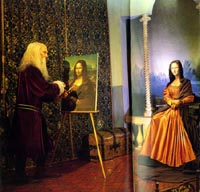Scientists set to unveil secrets of Mona Lisa
The first major scientific analysis of the "Mona Lisa" in 50 years has uncovered some unexpected secrets, including signs that Leonardo da Vinci changed his mind about his composition, French and Canadian researchers said Tuesday.

Photographs taken with invisible infrared light and a special infrared camera suggest that at least one of the details was hiding in plain sight, the scientists and conservators said.
The sitter in the Louvre Museum’s 16th-century masterpiece, believed to be Lisa Gherardini, the wife of a Florentine silk merchant, was originally painted wearing a large transparent overdress made from gauze, they said. Under normal light, part of the garment is visible on the right-hand side of the painting, but appears simply to be part of the background.
"You can see it when you know what you’re looking for," said Bruno Mottin, a curator in the research department of the Center of Research and Restoration of the Museums of France, known as C2RMF. He spoke at a news conference with researchers from the National Research Council of Canada, informs New York Times.
According to ABC News, a team of scientists from Canada's National Research Council has now created a 3-D digital model of the "Mona Lisa" — a highly detailed computer scan of what may be the most famous painting in history.
They did it in 16 hours in a basement photo studio at the Louvre in Paris, where the painting is on display.
They have been poring over the results for nearly two years, and reported their first findings today.
They found that the wooden board on which da Vinci painted the portrait is slightly warped, but in surprisingly good shape, considering that the work was done between 1503 and 1506.
The oil paint is mottled with fine cracks, as happens to many old paintings, but the paint appears well-bonded to the wood beneath it.
Parts of the scan, done in X-rays and other wavelengths, show damage near the top of the painting, and a repair made after a visitor threw a stone at it in 1956.
Some of the paint near Lisa's right elbow is also an apparent attempt to repair earlier damage.
According to Antara, the real Mona Lisa had three children. Da Vinci was commissioned by wealthy Florentine businessman Francesco del Giocondo to paint his wife between 1503 and 1506 after the birth of their second child, but he kept it and worked on it until his death, likely changing her hair and other features.
In the original "Mona Lisa," the subject gripped her chair more tightly, and she is not resting against the back of her chair, as some believed, but sitting upright, scans showed.
Researchers also gleaned insights about the Da Vinci's painting technique, including his sfumato or smoke technique of soft, heavily shaded modeling, said Mottin.
"There is no special mystery in the painting like in (Dan Brown's book) 'The Da Vinci Code,'" he said. "But, in that painting, Leonardo tried to capture the essence of life ... It embodies all his skills ... That is the true mystery we've uncovered."
Subscribe to Pravda.Ru Telegram channel, Facebook, RSS!


